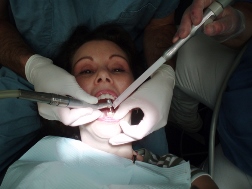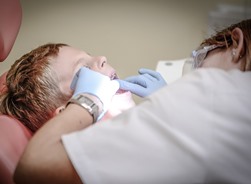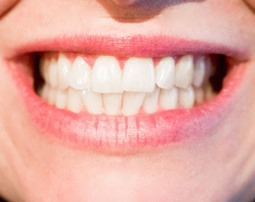How to Find the Right Dental Hygienist Program near Union Oregon
 Picking the right dental hygienist school near Union OR is an important first step toward beginning your new career in dentistry. But before you can make your selection, you must assess and compare your school options. There is far more to performing your due diligence than choosing the school with the least expensive tuition or enrolling in the college that is closest to your residence. There are other important issues to take into account as well, including the college’s accreditation and reputation. Dental hygienists generally earn an Associate Degree, as compared to a certificate usually earned by assistants, and can take anywhere from 2 to 3 years to complete. Obviously with the more extensive training of a hygienist comes more expense. We will explore all of these factors and supplemental questions that you should be asking the dental hygienist schools you are looking at later in this article. But first, let’s look at the duties of dental hygienists and the training programs available.
Picking the right dental hygienist school near Union OR is an important first step toward beginning your new career in dentistry. But before you can make your selection, you must assess and compare your school options. There is far more to performing your due diligence than choosing the school with the least expensive tuition or enrolling in the college that is closest to your residence. There are other important issues to take into account as well, including the college’s accreditation and reputation. Dental hygienists generally earn an Associate Degree, as compared to a certificate usually earned by assistants, and can take anywhere from 2 to 3 years to complete. Obviously with the more extensive training of a hygienist comes more expense. We will explore all of these factors and supplemental questions that you should be asking the dental hygienist schools you are looking at later in this article. But first, let’s look at the duties of dental hygienists and the training programs available.
[campusexplorer header_text=”Find Dental Hygienist Schools Near You!” aos=”75346615″ concentration=”2D77CE61″ tracking=”DENTHYG”]
The Job of a Dental Hygienist
 When comparing the duties of a dental hygienist to that of an assistant, the main difference is undoubtedly that the hygienist works more independently. Dental assistants work with and in support of the Union OR dentists and the practice. Hygienists, while also supporting the practice, deal with the patients more on a one-to-one basis. They are typically the first person a patient encounters when called from the waiting area. They examine every patient’s gums and teeth and report their results to the dentists. They may also carry out basic procedures. Based on state law, a hygienist’s responsibilities can include:
When comparing the duties of a dental hygienist to that of an assistant, the main difference is undoubtedly that the hygienist works more independently. Dental assistants work with and in support of the Union OR dentists and the practice. Hygienists, while also supporting the practice, deal with the patients more on a one-to-one basis. They are typically the first person a patient encounters when called from the waiting area. They examine every patient’s gums and teeth and report their results to the dentists. They may also carry out basic procedures. Based on state law, a hygienist’s responsibilities can include:
- Removing stains, tartar and plaque
- Administering fluoride treatments
- Polishing teeth and applying sealants
- Teaching patients regarding oral hygiene
- Taking X-rays and developing film
- Removing sutures and applying fillings
To qualify for licensing in almost all states, dental hygienists must graduate from a Commission on Dental Accreditation (CDA) accredited dental hygiene program. They must also pass the National Board Dental Hygiene Examination in addition to passing any state licensure exams. Once they have completed these requirements they are considered fully licensed and can add the “RDH” designation to their names, standing for Registered Dental Hygienist.
Dental Hygienist Training Options
As a result of the increased responsibility as compared to an assistant, dental hygienists working in Union OR dental practices are often required to hold an Associate Degree in dental hygiene rather than a certificate. These programs can require anywhere from 2 to as long as 3 years to complete and must be accredited by the CDA in virtually every state. They are offered in community colleges as well as trade and technical schools. And in addition to classroom studies learning the fundamentals of dental hygiene, there will be a clinical component to the training as well| Many programs also sponsor internships with local dental practices or dentists.
Online Dental Hygienist Colleges
 Selecting an online dental hygienist college can be a viable option for obtaining your education. Just remember that the program will not be completely online, since there will be a practical component to your training. But the remainder of your classes will be accessible by means of your personal computer in the convenience of your Union OR home or anywhere else on your laptop or tablet. For those working while attending college, online dental classes make education far more accessible. Some may even offer lower tuition costs than their traditional competitors. And supplementary expenses such as for commuting, books and school supplies may be lessened as well. The practical training can often be completed at a community dental practice or in an on-campus lab. With both the clinical and online training, everything necessary to get the proper education is furnished. If you have the discipline for this method of learning, you might find that attending an dental hygienist online school is the right option for you.
Selecting an online dental hygienist college can be a viable option for obtaining your education. Just remember that the program will not be completely online, since there will be a practical component to your training. But the remainder of your classes will be accessible by means of your personal computer in the convenience of your Union OR home or anywhere else on your laptop or tablet. For those working while attending college, online dental classes make education far more accessible. Some may even offer lower tuition costs than their traditional competitors. And supplementary expenses such as for commuting, books and school supplies may be lessened as well. The practical training can often be completed at a community dental practice or in an on-campus lab. With both the clinical and online training, everything necessary to get the proper education is furnished. If you have the discipline for this method of learning, you might find that attending an dental hygienist online school is the right option for you.
Issues to Ask Dental Hygienist Programs
 Now that you have decided to become a dental hygienist in Union OR, you can start the procedure of comparing schools and programs. As we discussed at the start of this article, many prospective students begin by looking at the location and the cost of the colleges. Maybe they search for several online alternatives as well. Even though these are significant initial considerations, there are a few additional questions that you need to ask of the colleges you are comparing in order to reach an informed decision. Toward that end, we have included a list of questions to assist you with your evaluation and final selection of the best dental hygienist program for you.
Now that you have decided to become a dental hygienist in Union OR, you can start the procedure of comparing schools and programs. As we discussed at the start of this article, many prospective students begin by looking at the location and the cost of the colleges. Maybe they search for several online alternatives as well. Even though these are significant initial considerations, there are a few additional questions that you need to ask of the colleges you are comparing in order to reach an informed decision. Toward that end, we have included a list of questions to assist you with your evaluation and final selection of the best dental hygienist program for you.
Is the Dental School Accredited? There are a number of valid reasons why you should only pick an accredited dental hygienist program. If you are intending to become licensed or certified, then accreditation is a prerequisite in virtually all states. To qualify to take the National Board Dental Hygiene Exam, your dental program must be accredited by the Commission on Dental Accreditation (CDA). Accreditation also helps ensure that the education you receive is comprehensive and of the highest quality. Union OR employers typically desire or require that job applicants are graduates of accredited colleges. And finally, if you are requesting financial aid or a student loan, often they are not obtainable for non-accredited schools.
Is Sufficient Clinical Training Included? Practical or clinical training is an essential part of any dental training program. This is true for the online college options also. Many dental hygienist colleges have associations with area dental offices and clinics that furnish practical training for their students. It’s not only important that the college you enroll in offers adequate clinical hours but also provides them in the type of practice that you subsequently want to work in. As an example, if you have an interest in a career in pediatric dentistry, check that the program you choose offers clinical rotation in a local Union OR dental practice that focuses on dental treatment for children.
Is There an Internship Program? Find out if the dental colleges you are exploring have an internship program. Internships are undoubtedly the best way to obtain hands-on, clinical experience in a professional dental practice. They help students to transition from the theoretical to the practical. They can also help students establish professional relationships in the Union OR dentistry community. And they look good on resumes also.
Is Job Placement Support Furnished? Many students that have graduated from dental hygienist schools need help getting their first job. Find out if the programs you are considering have job placement programs, and what their job placement rates are. Schools with higher job placement rates probably have excellent reputations within the Union OR dental community as well as extensive networks of contacts where they can refer their students for internships or employment.
Are Classes Smaller? Ask the colleges you are looking at how large typically their classes are. The smaller classes generally offer a more personal atmosphere for training where students have greater access to the teachers. On the other hand, large classes tend to be impersonal and provide little one-on-one instruction. If practical, find out if you can monitor a few classes at the Union OR dental hygienist college that you are leaning toward in order to witness first hand the degree of interaction between instructors and students before making a commitment.
What is the Total Cost of the Program? Dental hygiene programs can differ in cost based on the duration of the program and the volume of clinical training provided. Other variables, such as the reputations of the colleges and if they are public or private also come into play. But besides the tuition there are other significant costs which can add up. They can include costs for such things as commuting and textbooks as well as school equipment, materials and supplies. So when comparing the cost of programs, remember to include all of the expenses related to your education. Most colleges have financial assistance departments, so be sure to find out what is available as far as loans, grants and scholarships in the Union OR area.
Are the Classes Accessible? Before enrolling in a dental hygienist college, you must verify that the assistant or hygienist program furnishes classes that suit your schedule. This is especially true if you will be working while receiving your education and need to attend classes near Union OR at nights or on weekends. And even if you select an online school, you will still be required to schedule your practical training classes. Also, while addressing your concerns, ask what the make-up protocol is if you should have to miss any classes because of illness, work or family responsibilities.
Attending Dental Hygienist School near Union OR?
Soviet Union
The Soviet Union (Russian: Сове́тский Сою́з, tr. Sovétsky Soyúz, IPA: [sɐˈvʲɛt͡skʲɪj sɐˈjus] ( listen)), officially the Union of Soviet Socialist Republics (Russian: Сою́з Сове́тских Социалисти́ческих Респу́блик, tr. Soyúz Sovétskikh Sotsialistícheskikh Respúblik, IPA: [sɐˈjus sɐˈvʲɛtskʲɪx sətsɨəlʲɪsˈtʲitɕɪskʲɪx rʲɪˈspublʲɪk] ( listen)), abbreviated as the USSR (Russian: СССР, tr. SSSR), was a socialist state in Eurasia that existed from 1922 to 1991. Nominally a union of multiple national Soviet republics,[a] its government and economy were highly centralized. The country was a one-party state, governed by the Communist Party with Moscow as its capital in its largest republic, the Russian Soviet Federative Socialist Republic. Other major urban centres were Leningrad, Kiev, Minsk, Tashkent and Novosibirsk. The Soviet Union was one of the five recognized nuclear weapons states and possessed the largest stockpile of weapons of mass destruction.[7] It was a founding permanent member of the United Nations Security Council, as well as a member of the Organization for Security and Co-operation in Europe (OSCE) and the leading member of the Council for Mutual Economic Assistance (CMEA) and the Warsaw Pact.
The Soviet Union had its roots in the October Revolution of 1917, when the Bolsheviks, led by Vladimir Lenin, overthrew the Russian Provisional Government which had replaced Tsar Nicholas II during World War I. In 1922, after a civil war, the Soviet Union was formed with the unification of the Russian, Transcaucasian, Ukrainian and Byelorussian republics. Following Lenin's death in 1924 and a brief power struggle, Joseph Stalin came to power in the mid-1920s. Under Stalin's leadership, the Soviet Union transitioned from a market economy into a centrally planned economy which led to a period of rapid industrialization and collectivization. As industrial production skyrocketed, the Soviet Union achieved full employment, implemented a universal healthcare system, sharply reduced illiteracy, and provided guarantees of paid vacations, rest homes, and recreational clubs. This period of industrialization was a time of enormous improvements in the standard of living for millions of people in the country, starkly contrasting with the situations of other countries during the Great Depression, but was also a time characterized by major institutional shortcomings and failures. In the 1930s, with the rise of fascism in Europe, the Communist Party pursued aggressive campaigns to suppress potential counter-revolution, fermenting political paranoia which culminated in the Great Purge in which extrajudicial arrests and executions of suspected counter-revolutionaries led to an estimated 600,000 deaths. As a result of these mass arrests, penal labor through the Gulag system was used to construct infrastructure projects, though this consistently proved to be an inefficient system throughout its existence.[8] Increased demand for agricultural products to pay for industrialization combined with a relatively low harvest yield led to the famine of 1932-33 in which an estimated 2.4 to 4 million people died in the country's agricultural centers of Ukraine, southern Russia, and Kazakhstan.[9][10]
After the rise of Adolf Hitler in Germany, Stalin tried repeatedly to form an anti-fascist alliance with other European countries. However, finding no support, shortly before World War II, the Soviet Union became the last major country to sign a treaty with Germany with the Molotov–Ribbentrop Pact, after which the two countries invaded Poland in September 1939. In June 1941, the pact collapsed as Germany invaded the Soviet Union, opening the largest and bloodiest theatre of war in history. Soviet war casualties accounted for the highest proportion of the conflict in the effort of acquiring the upper hand over Axis forces at intense battles such as Stalingrad and Kursk. The territories overtaken by the Red Army became satellite states of the Soviet Union; the postwar division of Europe into capitalist and communist halves would lead to increased tensions with the West, led by the United States.
The Cold War emerged by 1947, as the Eastern Bloc, united under the Warsaw Pact in 1955, confronted the Western Bloc, united under NATO in 1949. On 5 March 1953, Stalin died and was quickly succeeded by Nikita Khrushchev, who in 1956 denounced Stalin and began the De-Stalinization of Soviet society through the Khrushchev Thaw. The Soviet Union took an early lead in the Space Race, with the first artificial satellite and the first human spaceflight. Khrushchev was removed from power by his colleagues in 1964 and was succeeded as head of state by Leonid Brezhnev. In the 1970s, there was a brief détente of relations with the United States, but tensions resumed with the Soviet–Afghan War in 1979. In the mid-1980s, the last Soviet leader, Mikhail Gorbachev, sought to reform and liberalize the economy through his policies of glasnost (government transparency) and perestroika (openness, restructuring). Under Gorbachev, the role of the Communist Party in governing the state was removed from the constitution, causing a surge of severe political instability to set in. The Cold War ended during his tenure, and in 1989, Soviet satellite states in Eastern Europe overthrew their respective communist governments.
Choose the Ideal Dental Hygienist College near Union OR
Selecting the right dental hygienist program is crucial if you want to take the National Board Dental Hygiene exam or, if required in your state, become licensed. As we have covered, there are a number of options available to obtain your education and it takes a relatively short period of time to become a dental hygienist. You can obtain your formal training through dental programs at junior colleges, technical institutes, trade schools and vocational schools. Graduates of these programs generally obtain an Associate Degree. Dental Hygienists typically require about two years of studies prior to entering the job market. When obtaining a degree you can choose to attend classes on-campus or online. Whichever mode of training you elect to pursue, by asking the questions presented in this article you will be better prepared to make the ideal choice. And by doing so, you will be ready to commence your journey toward becoming a dental hygienist in Union OR.
More Great Cities in Oregon
Business Results 1 - 10 of 1


